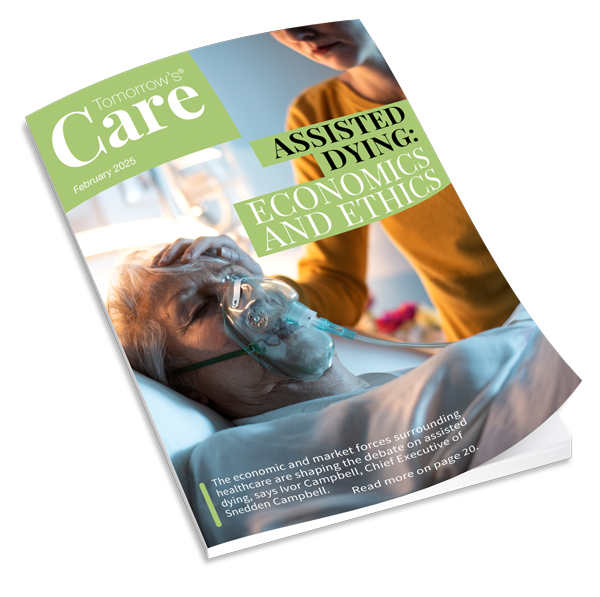You are here
- Home
- >
- Industry Comment
- >
- Global Tea Party Nutrition and Hydration Week
HOW TO CREATE AN INCLUSIVE GLOBAL TEA PARTY THIS NUTRITION AND HYDRATION WEEK

Published on 13/03/2023
One of the highlights of Nutrition and Hydration Week (13-19 March 2023) is its Global Tea Party, which this year takes place on Wednesday 15 March.
On this day, Nutrition and Hydration Week participants are invited to hold tea parties in their organisations. This, it is hoped, shows their commitment to nutritional care. It helps improve nutritional intake for those they care for. And it’s also a great way to bring people together and create some joy and fun.
Fresh from the launch of their newest publication, Vegan Texture-Modified, two chefs from care charity Vegetarian for Life share their tips on creating a Global Tea Party that is inclusive for all.
Q: Tell us about the importance of food-related celebrations, such as the Nutrition and Hydration Week Global Tea Party
A: VfL Roving Chef, Alex Connel: “So much of our culture and indeed pleasure revolves around food. From birthdays, barbecues, Sunday roast, Christmas, and afternoon teas, the list goes on.
"Food is not only is it important for good physical health but for mental wellbeing too. Any hindrance to enjoyment can lead to social isolation and poor health.
“The good news is with a little thought, even people needing a textured-modified diet can enjoy and take part in any social event involving food. The trick is to follow the guidelines and get creative.”
Q: And you’ve produced an innovative new guide specifically with texture-modification in mind?
A: Vegetarian for Life Roving Chef, Justina Bajorinaitė: “Yes – we’ve added to our range of vegan and vegetarian (veg*n) publications, by creating Vegan Texture-Modified to support veg*ns with swallowing difficulties. The new guide is a collection of vegan and vegetarian recipes, perfect for vegans, vegetarians or those with egg or milk allergies, who need a texture-modified diet.
“And it’s not just useful for those catering for veg*ns. Chefs can use it to gain a better understanding of how to prepare vegetables correctly, maximising the colour and presentation of each dish.”
Q: Who is this guide and the recipes for?
A: Alex: “The guide is aimed at any person that prepares food that requires texture modification. The recipes are all vegan, so obviously can be enjoyed by those following a vegan diet. However, the recipes are familiar favourites that any person needing a texture-modified diet can enjoy.”
Q: How did you come up with the idea for the guide?
A: Justina: “Dysphasia training seems to be becoming more and more popular. Understanding how to prepare food to the correct IDDSI level is just a part of this task. The other important aspect is how to make puréed or diced foods look just as appealing as wholefood items – for example, how to differentiate between broccoli and pea purée on the plate for those who consume it. And also boosting flavours with the help of ingredients in the pantry.”
Q: How did you find learning about creating textured-modified food? Was it easy to learn?
A: Alex: “In order to develop the recipes and get them to meet the IDDSI framework we undertook quite a bit of research and training, including hands-on. At first it is difficult to get to grips with the various IDDSI levels, particularly when you consider how important it is to make sure they are correct. The point of the framework is standardisation. One recipe created by one chef at a specific IDDSI level should have the same consistency as another recipe created by different chef at the same IDDSI level.”
Q: What awareness do you want to bring about with this guide and your IDDSI work?
A: Alex: “It can’t be underestimated how important eating a healthy diet is, and meeting the dietary requirements of any individual. A person following a vegan or vegetarian diet may have done so for years and have deep philosophical reasons for doing so. As a carer it is your job to support those choices. This guide is a starting point for chefs and carers to be able to create delicious and nutritious meals.”
Q: How did you come up with the recipe ideas?
A: Justina: “The recipe ideas were not easy to come up with, I must be honest! Not every dish is easy to make ‘dysphagia-friendly’ – particularly bread, pasta, or vegetables such as celery. We had to put our thinking caps on and carefully consider recipes that would be useful, suitable to make throughout the day, and most importantly, look presentable.”
Q: What surprised you with these recipes?
A: Alex: “As a chef, one of the key factors when creating a recipe is contrast of textures. Obviously with IDDSI this can’t be the case. However, despite this, what surprised me was that all of the recipes are still full of flavour and delicious.”
A: Justina: “For me, the most surprising thing was the amount of liquid needed to achieve puréed IDDSI levels. There was always that feeling of “I think I should add more”. But actually, after working the mixture in the liquidiser, and then through the sieve, the texture became more watery. It is harder to remove too much liquid, but not impossible, by cooking the mixture.”
Q: What are your catering tips for texture-modified diets on special occasions, such as an afternoon party?
A: Justina: “After a speech therapist’s assessment, you’ll know which textures are suitable for the individual that you’re catering for. Perhaps the person will be allowed to consume moistened biscuit – imagine a little like a layer in a tiramisu. Perhaps they may be able to enjoy a milkshake or a chocolate mousse. Do not assume that person ‘will be okay’. The food needs to be specifically prepared for this person to suit their IDDSI level, including thickened tea or coffee.”
A: Alex: “For an afternoon tea, depending on the IDDSI level needed, some cake can be puréed and piped back into an attractive shape with a contrast of colours. Other cakes such as cheesecake may need very little modification, other than the base. Depending on the IDDSI level, even bread can be puréed and piped with a filling as sandwiches. As with any food preparation this should be done to meet the needs of the individual.”
Download your free copy of Vegan Texture-Modified from Vegetarian for Life’s websitehttps://vegetarianforlife.org.uk/publications. Hard copies cost just £2.75 inc P&P.
Related News
Categories
- CQC ratings
- Care home news
- Care jobs
- Care planning
- Care sector awards
- Care sector events
- Care sector news
- Care staff
- Charity
- Cleaning & Hygiene
- Construction
- Dementia
- Disability
- Entertainment
- Finance
- Fitness
- Food & Drink
- Fundraising
- Furniture
- Health & Safety
- Healthcare
- Hospice & Palliative Care
- Hospitals
- Industry Comment
- Interiors
- Laundry
- Legal
- Leisure
- Medication
- Mental Health
- Mobility
- New appointments
- PPE
- Products
- Property
- Recruitment
- Relationships
- Research
- Safeguarding
- Security
- Services
- Social care
- Sustainability
- Technology
- Training
- Transport
- Uniforms
- Waste
- Wearables

























